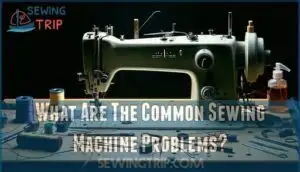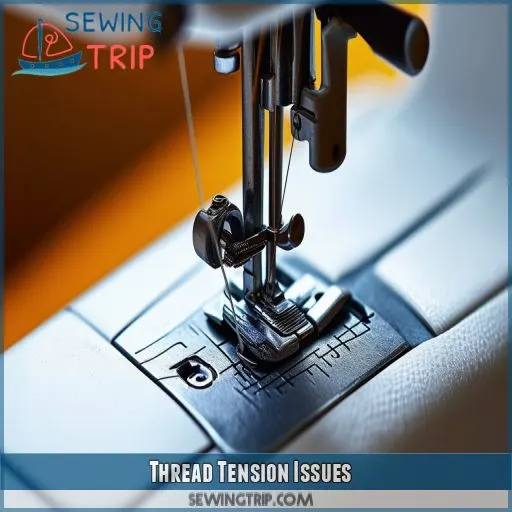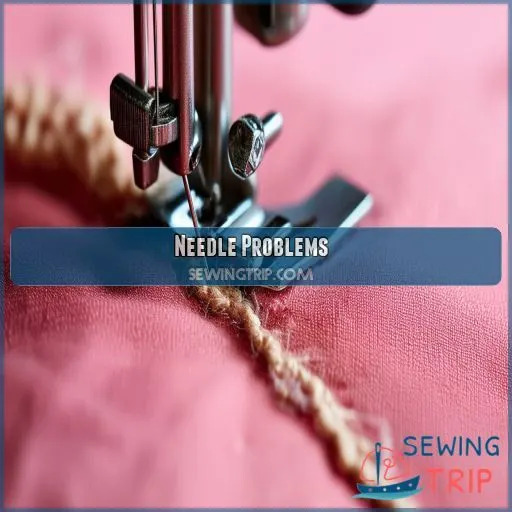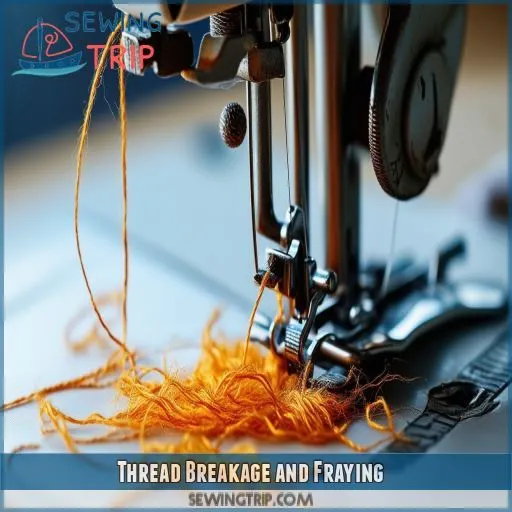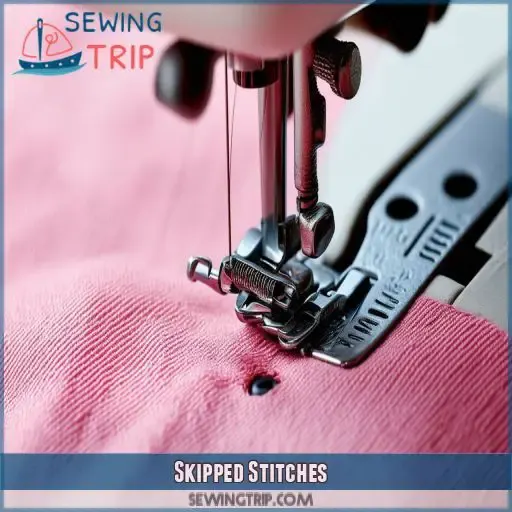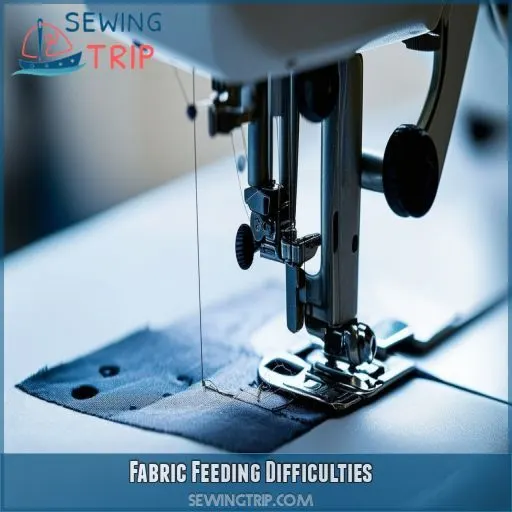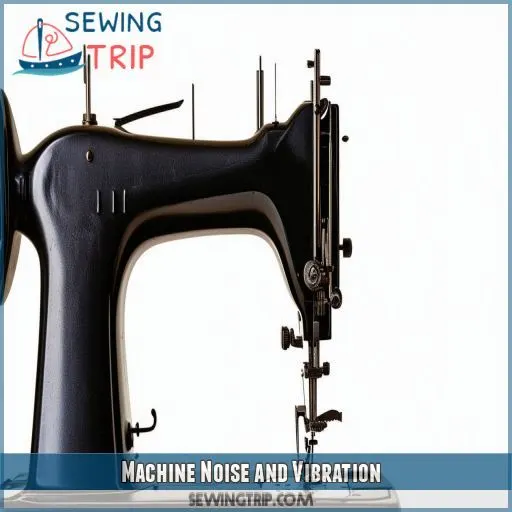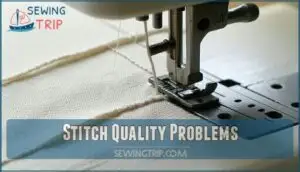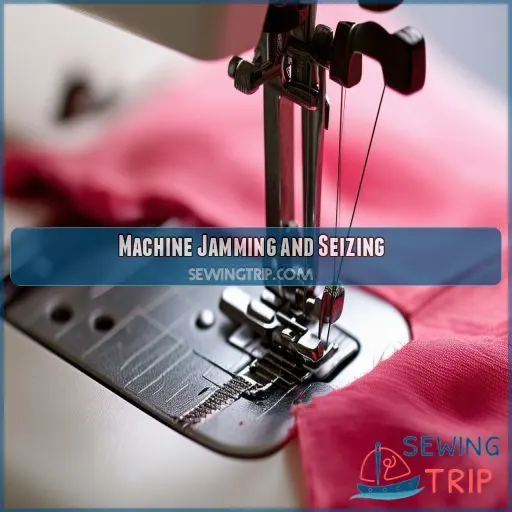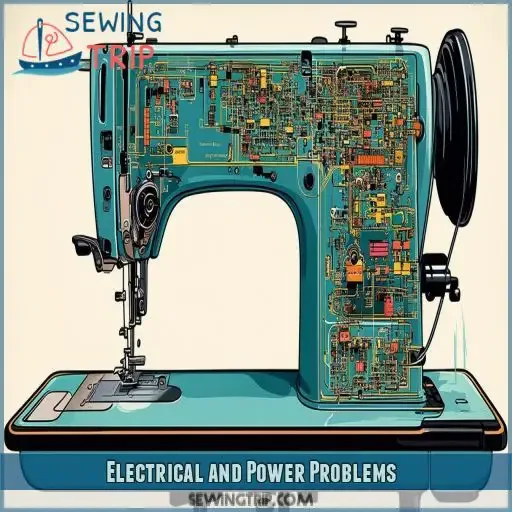This site is supported by our readers. We may earn a commission, at no cost to you, if you purchase through links.
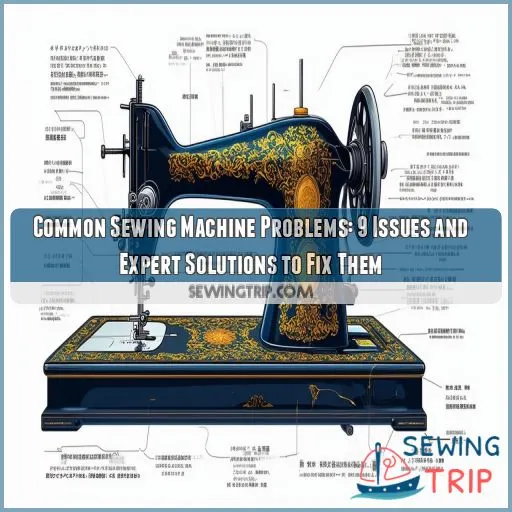
The article will give nine common issues with sewing machines and expert solutions on how best to fix them. You will discover some practical insights into how to keep your sewing machine running, from problems with the needles to electrical faults, all solved.
Table Of Contents
- Key Takeaways
- What Are the Common Sewing Machine Problems?
- Thread Tension Issues
- Needle Problems
- Thread Breakage and Fraying
- Skipped Stitches
- Fabric Feeding Difficulties
- Machine Noise and Vibration
- Stitch Quality Problems
- Machine Jamming and Seizing
- Electrical and Power Problems
- Frequently Asked Questions (FAQs)
- Conclusion
Key Takeaways
- Don’t let thread tension issues drive you batty! Your machine will thank you for the delicate adjustment TLC.
- Say no to thread mishaps! Ensure your machine is threaded with the finesse of a surgeon.
- Keep your machine buzzing happily by banishing lint and dust bunnies – they’re the sewing machine’s kryptonite!
- If your machine starts acting up like a rebellious teenager, don’t hesitate to seek professional help – they’ll get it back in tip-top shape!
What Are the Common Sewing Machine Problems?
When dealing with common sewing machine problems, you’re often up against thread tension issues, needle problems, and thread breakage. Uneven stitches and puckered seams usually mean tension problems, requiring adjustments to the upper or lower thread tension.
Bent or incorrect-sized needles can cause skipping stitches, while poor-quality thread often leads to breakage and fraying. Fabric feeding difficulties might stem from misaligned feed dogs or incorrect presser foot usage.
Machine noise or vibrations indicate lubrication needs or loose parts. Jams and power issues can disrupt your sewing too. There’s much to tackle, but understanding these basics is your first step toward smoother sewing
Thread Tension Issues
Thread tension issues can’t only be a great pain but will also negatively impact your sewing using the upper and lower threads. Now, you’ll need to adjust the upper thread tension and the lower thread tension, along with their balance, so that the stitches come out even and secure.
Upper Thread Tension
When your upper thread tension‘s off, you’ll notice uneven stitches, puckered seams, or thread bunching. Check your tension discs for debris or wear. Adjust the dial carefully, testing on scrap fabric. If threads keep breaking or fraying, you might need to rethread or replace your needle. Balancing tension’s key to perfect stitches
Lower Thread Tension
While the upper tension is important, so is the balance from your lower thread tension. In this respect, your bobbin case has much to do with it. Check for:
- Bobbin case misalignment
- Loose screws on the bobbin case
• Incorrect type of bobbin thread
These factors can play havoc with your stitches. If you’ll adjust this bobbin tension spring carefully, it can solve most of the sewing machine problems.
Balanced Tension
Balanced tension is necessary to get perfect stitches. You’ll need to set both the upper and lower tensions. Here’s how:
| Issue | Symptom | Solution |
|---|---|---|
| Loose upper | Loops on bottom | Increase top tension |
| Tight top | Loops at the top | Top tension decrease |
| Bobbin tension | Varied stitches | Adjust bobbin case screw |
| Balanced | Even stitches | No adjustment needed |
Needle Problems
Needle issues would have a significant effect on the operation of your sewing machine as well as affecting the quality of your projects. There are bound to be issued where your needle gets bent or broken; you’re using the wrong size of needle for your fabric, and improper needle insertions—all causing frustrating sewing experiences.
Bent or Broken Needles
Aside from tension problems, bent or broken needles is probably the most common cause of the following :
- The machine occasionally skips stitches
- Fabric or threads gathering
- Needle Is Working Its Way Out
- Snapped needles jamming the machine
Test time: Check for alignment of your needle bars and holes. Replace bent or dull needles at once to eliminate damage and provide smooth sewing.
Incorrect Needle Size
You’re using the wrong needle size if your fabric’s not feeding or stitches are skipping. Match needle size to thread weight and fabric type. A too-small needle can break, while a too-large one leaves visible holes. Incorrect needle size can cause uneven pressure, leading to sewing machine problems
Needle Insertion Issues
You’ve got the right needle, but it’s not working? Check your insertion technique. Make sure you’re not putting it in backwards or at the wrong angle. If your needle’s not moving, it might be improperly inserted. Remember, gentle force is key when inserting the needle into your machine
Thread Breakage and Fraying
Thread breakage and fraying can be frustrating issues that disrupt your sewing projects. You’ll often find that poor quality thread, incorrect threading of your machine, or tension imbalances are the primary culprits behind these problems
Poor Quality Thread
Poor quality thread can wreak havoc on your sewing projects. You’ll notice frequent thread breaks, unraveling, twisting, and shedding. This can lead to skipped stitches, inconsistent fabric feed, and puckered seams. To avoid these headaches, invest in high-quality threads that match your fabric type and project requirements
Incorrect Threading
Messing up your threading can be pretty disastrous in your sewing project. You’ll face a lot of irritating breakage and fraying of the thread if you aren’t careful. Here’s the scoop on how to tackle this common sewing machine problem:
- Carefully follow the threading guide for your machine
- Check the presser foot lever, up for when threading
- Verify that the bobbin is installed correctly
- Use the right needle and thread size.
Tension Imbalance
When your thread keeps breaking, tension imbalance might be the culprit. Check your upper and lower tensions. Adjust the tension discs carefully, as they control thread flow. If seams in stretch fabrics come out wavy, it’s often a sign of improper tension. Balancing bobbin and upper tensions is key to solving this common sewing machine problem
Skipped Stitches
Skipped stitches are usually caused by obstructions in the needle’s path, the presser foot being too tight, or the poor feeding of the material. You will, therefore, need to ascertain that your needle isn’t bent or dull, set the pressure on the presser foot to fit the fabric you’re using, and demonstrate that the feed dogs are engaging material.
Needle Issues
If your thread is breaking, the trouble may be in your needle. The needles bend and can become dull. This, too, may cause skipped stitches. Be sure to use a proper needle gauge for the appropriate fabric. Adequate storage and sharpening will avoid these problems. Remember that smooth sewing is a well-maintained needle.
Incorrect Presser Foot Pressure
After addressing needle issues, let’s tackle incorrect presser foot pressure. If you’re experiencing skipped stitches or fabric distortion, it might be due to excessive pressure. This can cause uneven stitches and even affect decorative stitch settings. Adjust the pressure to match your fabric’s weight for smoother sewing
Fabric Feed Problems
If your fabric’s bunching or creating wavy seams, you might’ve feed problems. Check your feed dogs for debris or damage. Adjust the pressure on your presser foot to match your fabric’s weight. For stretchy materials, use a walking foot to prevent fabric seizing and needle unthreading. This’ll minimize thread bunching at seam ends
Fabric Feeding Difficulties
Your sewing machine’s fabric feeding system can encounter issues with the feed dogs, presser foot, or specific fabric types. These problems can manifest as uneven fabric movement, skipped stitches, or puckered seams, affecting the quality of your sewing projects
Feed Dog Issues
Feed dog problems can worsen skipped stitches. Align feed dogs and height to ensure the smooth movement of fabric. Remove lint and dirt from feed dogs regularly. If the problem persists, feed dog replacement. Keep the feed mechanism of your machine maintained to avoid future feeding problems and be assured of stitch quality maintenance.
Presser Foot Problems
The presser foot is significant for moving your fabric under the machine smoothly.
First, check that the hole is aligned with the needle and that the height is appropriate for the thickness of your fabric. Should you fail to adjust pressure properly, the stitching may result in skipping or jamming.
Be sure to use the right type of presser foot for whatever you’re sewing. Using the wrong kind will lead to poor feed and uneven stitches
Fabric Type Challenges
You’ve mastered presser foot issues, but fabric types can still cause hiccups. Different materials require specific handling to prevent:
- Fabric puckering in delicate fabrics
- Stretch fabric distortion
- Seam waviness in knits
- Fabric bunching at seam ends
- Thread bunching under lightweight materials
Adjust your technique and machine settings accordingly
Machine Noise and Vibration
If your sewing machine makes strange noises or starts shaking a lot, most likely it’s a problem of insufficient lubricating, loose parts, or accumulation of small-scale debris. Regular maintenance, such as oiling the moving parts, screw tightening, and cleaning of the lint and thread remnants, will significantly reduce these problems and help the machine work harmoniously.
Lubrication Needs
Lubrication is necessary. Use the proper lubricant in oil or grease at regular periods; run your machine just like its manufacturer’s oiling guide and maintenance schedule specified. Proper lubricant application reduces noise and vibrations and guarantees a smooth sewing process.
Loose Parts
This machine’s noise and vibration could be from loose parts. Check for a loose bobbin, presser foot, or a loose belt. Also, inspect for loose screws to the machine or the loose case. Ensuring tightening here can go much in reducing noise and ensuring smoother, more reliable operation.
Debris Accumulation
Debris accumulation may result in the noise and vibration of the machine, which is inconvenient when sewing. Keep it free from debris. Make use of cleaning tools such as brushes and lint removers to keep your machine in pristine condition. Describe:
- Bobbin case
- Dogs fed
- Friction pads
Proper sewing machine maintenance means smoother operation
Stitch Quality Problems
Stitch quality problems can cause uneven stitches, puckered seams, or looping threads, which can ruin your project and waste your time. Ensuring balanced tension, using the correct needle and thread, and proper machine maintenance will help achieve better stitch quality
Uneven Stitches
Uneven stitches can result from improper adjustment of the presser foot, improper adjustment of the tension in the bobbin, or the use of an inappropriate size in the sewing needle. There should be a relation between the type of fabric and the proper size of the sewing needles, optimizing the stitch length according to the thickness of the fabric.
| Problem | Cause | Solution |
|---|---|---|
| Uneven stitches | Bobbin tension is off | Adjust bobbin tension |
| Uneven stitches | Incorrect needle size | Choose correct needle size |
| Uneven stitches | Incompatible fabric and needle | Match the type of fabric with the size of the needle |
Puckered Seams
This is usually caused by incorrect seam allowances, thickness of the fabric, or even the stitch length. Check and alter the presser foot pressure and ensure that you’re using the right type of needle for your respective fabric. Proper balancing of these elements will create smooth, even seams that won’t pucker.
Looping Threads
Threading loops can drive you crazy! Follow these steps to solve the problem:
- Bobbin tension: Check that it’s set properly.
- Inspect bobbin winding: Check for even winding.
- Re-thread: Confirm the correct threading path.
- Change in thread: In case of fraying or shredding, a stronger thread should be used instead.
Machine Jamming and Seizing
When your sewing machine jams or seizes, it’s often due to thread jams, timing issues, or mechanical failures. Address these problems by carefully checking for tangled thread, ensuring proper timing between the needle and bobbin, and inspecting for any mechanical malfunctions that need fixing
Thread Jams
Thread jams often occur because of borderless wound bobbins or inappropriate needle use. Be sure to wind bobbins evenly so the thread doesn’t bunch. Proper threading will also help, but sometimes tensions need to be adjusted. Clean the machine frequently to remove lint or debris that could cause jamming or thread bunching.
Timing Issues
Timing can lead to your sewing machine jamming or seizing. The timer settings may be off, the timing gears are worn out, or the timing belt or pulley is misaligned. Ensure that the needle and hook are synchronized using the timing to guide these precision adjustments.
Mechanical Failures
Mechanical failures often lock up the sewing machine. Ensure proper needle placement and tighten it firmly. Check the presser foot pressure. Thread jams and tension imbalances can also be a problem, and your machine should be regularly cleaned and lubricated to prevent such issues and keep it running smoothly.
Electrical and Power Problems
Electrical and power failures in your sewing machine may result from poor power supply, motor breakdown, or errors on the control panel. Check to make all connections are secured, look out for any damaged wires, and see your manual for troubleshooting tips
Power Supply Issues
Be sure to plug your sewing machine power cord into the proper functioning power outlet and sewing machine. Check for any damage to the power adapter. Test stability to the source of your power to prevent power surges. A reliable power supply ensures there will be no disruptions when working.
Motor Malfunctions
If your sewing machine’s motor is overheating, making unusual noises, or not lasting as long as expected, it may be time for a repair or replacement. Consult your manual for motor maintenance tips, and don’t hesitate to seek professional help if the issue persists
Control Panel Errors
EEPROM failure, firmware updating issues, display problems, button failures, and ill-functioning LEDs are some control panel errors that may cause issues during sewing. Look for corrupted firmware or buttons that might’ve been damaged. Display and LED issues may be resolved by checking connections, running diagnostics, and updating the firmware to ensure smooth operations.
Frequently Asked Questions (FAQs)
What is the most common problem for a sewing machine?
Incorrect threading is the most common problem associated with the sewing machine. Improper thread placement can lead to thread breakage, skipped stitches, or jamming. Always ensure your threads are threaded properly before you start working on your day’s sewing projects.
How come my sewing machine won’t stitch?
If your sewing machine won’t stitch, it could be improperly threaded, a bent needle, or tangled bobbin. Addressing these issues often resolves the problem, helping you avoid feeling like you’re tilting at windmills
What is the average lifespan of a sewing machine?
Usually, the average lifetime of a sewing machine falls between 5 to 25 years. It varies depending on the level of use, whether or not it’s service-oriented, and the build’s quality. Proper care, along with regular servicing, can significantly elongate the functional life of the sewing machine, thereby ensuring more excellent performance reliability in tough times.
Why is my thread looping underneath?
Your thread loops underneath because the top tension of the machine is too loose, or the bobbin isn’t threaded correctly, or both. Check and adjust the top tension and check that the bobbin is inserted correctly and wound.
What are the most common sewing mistakes & machine problems?
Common sewing mistakes and machine problems include incorrect needle size, improper tension settings, poor threading, bent or blunt needles, irregular bobbin placement, dirty tension discs, and using the wrong presser foot for fabric weight
What is a sewing machine problem?
A sewing machine problem includes issues like thread bunching, broken needles, inconsistent tension, skipped stitches, improper fabric feed, and irregular bobbin activity. These can stem from incorrect threading, tension settings, and poor machine maintenance
What are the most common problems you face while sewing?
You often face thread bunching, broken needles, and fabric feeding issues. Additionally, inconsistent bobbin tension, skipping stitches, and machine noises can disrupt your sewing. Regular maintenance and correct needle and thread usage can mitigate these problems
Why is my sewing machine not working?
Oh, the joy of a stubborn machine! Your sewing machine likely has tension issues, incorrect threading, a blunt needle, or bobbin problems. Check these areas first to get back to smooth, hassle-free stitching
How often should I clean my machine?
You should clean your sewing machine after every 8-10 hours of use. In this way, regular maintenance performed by removing lint, oiling moving parts, and checking for any worn parts would help to run the apparatus smoothly for years.
What tools are essential for repairs?
What tools do you need for sewing machine repairs? You’ll need screwdrivers, tweezers, needle-nose pliers, a small brush, oil, and a multimeter to diagnose and fix common machine issues efficiently. Always have your machine’s manual handy
How do I properly oil my machine?
Regularly oil your sewing machine. Refer to the manual for the correct oil and locations. Apply a few drops, then turn on the machine to distribute. This keeps it running well.
When should I seek professional help?
Imagine your machine groaning, needles breaking, or stitches skipping. If you’ve tried adjusting tension, re-threading, or changing needles and it persists, it’s time to seek professional help to prevent further damage
What causes inconsistent bobbin tension?
Inconsistent bobbin tension generally might indicate Uneven bobbin winding, Incorrect placement of the bobbin in the bobbin case, Worn bobbin case spring Accumulation of lint Burr on the underside of the throat plate. Check and correct these problems to enable smooth sewing.
Conclusion
Undoubtedly, problems with a sewing machine can justifiably be a pain in the neck. However, with these expert solutions, you’ll be well prepared to meet head-on most everyday sewing machine problems.
From thread tension woes to electrical gremlins, you’re now armed with how best to keep your machine purring like a kitten that has just been greased.

